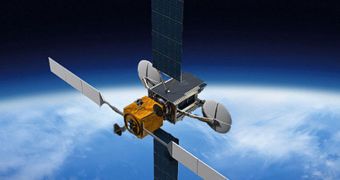Officials from ViviSat say that they are now ready to build and launch their Mission Extension Vehicle (MEV), a spacecraft designed specifically to rescue satellites stranded in Earth's orbit, and to provide minor repairs and adjustments to these spacecraft.
ViviSat is a joint venture between Allian Techsystems (ATK) and US Space. The former played an important role during the Space Shuttle Program, producing the engines used by the orbiters. Now, it is moving into the private sector.
If used at the large scale, the MEV has the potential to make the international satellite industry more efficient, especially in terms of mission duration. The vehicle is equipped with unique instruments that enable it to latch onto other satellites.
It can then use its own thrusters to maneuver the latter into new orbits, or correct anomalous flight paths. It is not uncommon for some satellites to be launched towards one orbit, and end up in another.
Since most spacecraft are designed for a specific purpose, which requires a precise orbit to complete, launching them into a different orbit constitutes mission failure. The vehicle and the money invested in it are entirely lost.
ViviSat says that MEV is the solution to such scenarios. It can be sent to rendezvous with stray satellites, latch onto them, and then maneuver them into their correct orbits. This will improve mission success rates, and enable satellite manufacturers to use their spacecraft to their full potential.
“We're ready to sell, we're ready to build, we're ready to deliver. Our target market is both commercial spacecraft as well as government spacecraft,” explained ViviSat's chairman of the board, Edward Horowitz, during a recent interview.
“If you just look at the commercial market, there are 350 to 360 satellites in geostationary orbit. Every year, 25 or so reach the end of their fuel life. Of that 25, we figure 10 are good target customers for this” he told Space last month, at the 28th National Space Symposium.
He added that satellite operators expressed interest in the MEV-based approach because it is passive, and does not imply removing any components from the target spacecraft, or refuel it in orbit.
Horowitz concluded by saying that satellites would be able to continue with their normal operations even if the MEV system was attached to them. “This enhances profitability because it allows operators to keep operating, so they keep their margins. It's no fuss, no muss and no mechanics,” he said.

 14 DAY TRIAL //
14 DAY TRIAL //